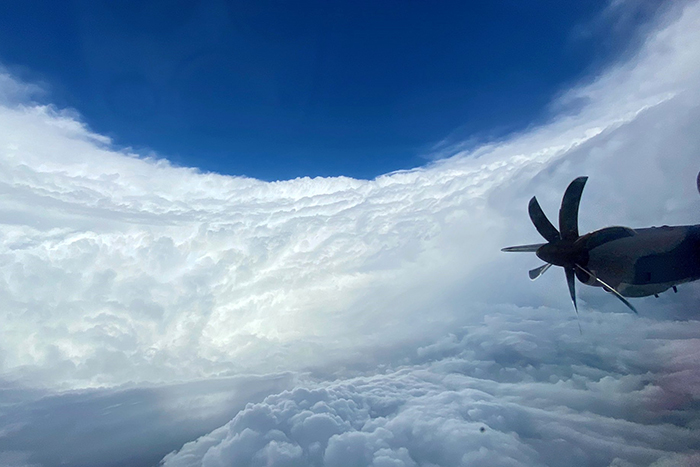Making the Unpredictable Predictable in Hurricane Forecasts
By Nilde Maggie Dannreuther and Xiaomin Chen

The structure of wind turbulence (visualized here with moist, cloudy air) is different under low- and high-wind conditions. On the right during low-wind conditions, moist air is driven upwards. On the left during high-wind conditions, moist air is driven sideways as well. The new modeling framework developed by Chen et al., allows hurricane forecasts to better reflect the high-wind conditions as a tropical cyclone develops. Figure by Xiaomin Chen. Left image by Sandro Puncet, with permission. Right image by Air Force Reserve 53rd Weather Reconnaissance Squadron
The new method they developed involves combining atmospheric data collected in a hurricane approximately 1 km above the ocean's surface (the Planetary Boundary Layer, PBL, also called the Hurricane Boundary Layer) with a special model (large-eddy simulations or LES) that can directly predict the behavior of wind turbulence or turbulent eddies. This combination assists a hurricane model to make predictions with reduced uncertainty because its calculations incorporate a more accurate reflection of the turbulent conditions as a tropical cyclone develops.
"We developed a modeling framework that integrates in-situ observations and LES to study the hurricane boundary layer," explained meteorologist Xiaomin Chen with Mississippi State University. "One important application of this framework is to assess the performance and uncertainties in various types of PBL parameterization schemes in hurricane conditions."
The in-situ observations that Chen referred to come from dropsonde, weather devices released during hurricane hunter flights into category 4 or 5 hurricanes from 1999–2010 that detect and record wind speed and direction, temperature, and moisture as the device falls through the atmosphere. The LES simulations using the observed hurricane conditions provided reliable information on the mean size of turbulence eddies and the energy produced by turbulent winds (turbulence kinetic energy or TKE) to evaluate and improve different types of PBL schemes used in hurricane models.

Inside the eyewall of 2020 Hurricane Epsilon as seen by the Hurricane Hunters 53rd Weather Reconnaissance Squadron
The issue with current PBL schemes is that they are generally designed for non-hurricane conditions, including the PBL scheme (TKE-based moist eddy-diffusivity mass-flux or EDMF-TKE) used in the latest NOAA model, the Hurricane Analysis and Forecast System (HAFS). Chen and his colleagues aimed to improve how PBL schemes are represented in the HAFS.
"Using our framework, we improved the EDMF-TKE PBL scheme in the NOAA HAFS," said Chen. "The modified EDMF-TKE scheme ensures a match between surface-layer and PBL parameterizations and adopts the information of turbulence eddies from LES."
By providing a PBL scheme that incorporates turbulence data from LES, the researchers help the model adjust its representation of fundamental physical processes to better reflect actual conditions as Chen summarized, "Using the LES output, the modified EDMF-TKE PBL scheme enhances boundary layer inflow and shows promise to improve forecast skill in the rapid intensification of landfalling hurricanes."
This research was supported by the NOAA Office of Oceanic and Atmospheric Research award to the Northern Gulf Institute and by the National Center for Atmospheric Research, a National Research Council Research Associateship Award, the Office of Naval Research, and the National Science Foundation.
- MSU's Raspet Flight Lab, an ASSURE Research Partner, Working with 911 Security to Ensure Safe Drone Use On Campus
- Hwang's Research to be Featured on CASC Brochure Cover
- Farm Press Features Mississippi State University, USDA Agricultural Research Service Supercomputing and Research Efforts to Advance Precision Agriculture
- NOAA-Supported Scientists from NGI Research Partner, Louisiana Universities Marine Consortium, Releases Report for Gulf of Mexico
- Tonia Lane Named Interim Director of MSU Institute for Imaging and Analytical Technologies
- AOML Features NGI Studies on eDNA Sampling Technology and an Ocean Acidification Buffer Zone
- ASSURE's Lead University, MSU, Hosts Competition Awarding $720,000 to Drone Enthusiasts for Their Innovative Ideas
- MyNBC5 Features ASSURE's Research Partnership with the University of Vermont and How They are Teaching First Responders How Drones Can Benefit Their Jobs
- ASSURE's Lead University, Mississippi State and Research Partner Kansas State University Conduct First Responders U.A.S. Triple Challenge
- MSU's Center for Cyber Innovation, MGCCC, Federal Partners Collaborate to Host Premier Cybersecurity Conference
- MSU Researcher and Faculty Member Named Associate Director of GRI
- GeoCue Group Inc. Features Mississippi State University's Geosystems Research Institute's Work Using TrueView for Airport Runway Extension
- GRI Researcher Uses Geospatial Techniques and Technology to Assist Farmers in Practical Ways
- Grad Students from Across the Country Benefit from GRI and USDA Graduate Summer Research Experience
- MSU Partnership with Italy's University of Salento Bolsters Utilization of Smart Technology, Advancing Sustainable Agriculture
- Below-average Gulf of Mexico 'dead zone' Measured by NOAA Supported NGI Partners
- NGI and Partners Share Research Information and Technologies at 2022 Gulf of Mexico Conference
- Jamese Sims Joins Northern Gulf Institute as Deputy Director, Strategic Advisor for Federal Partnerships
- NGI Supported Study Introduces Mitohelper – A Tool that Improves the Usability of Fish eDNA Data for Research
- Northern Gulf Institute Recognizes Scientists for Outstanding Research
- NOAA's NCEI and NGI Create Story Map that Shows Hurricane Ida's Impact on Vulnerable Communities from Louisiana to New York
- MSU NGI Meteorologist: Dry Air, Other Variables Taking Teeth out of Atlantic Hurricane Season
- ASSURE Partner, UVM Offer FEMA-funded Drone Training Program

